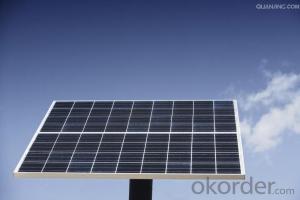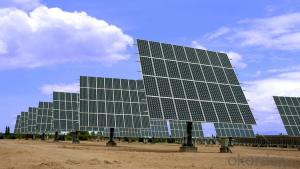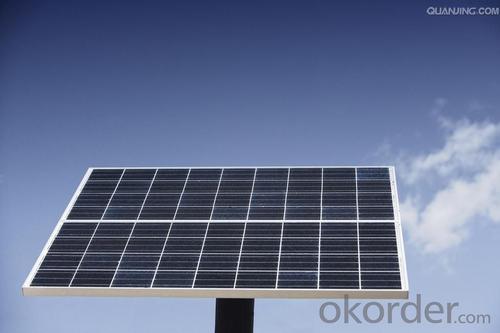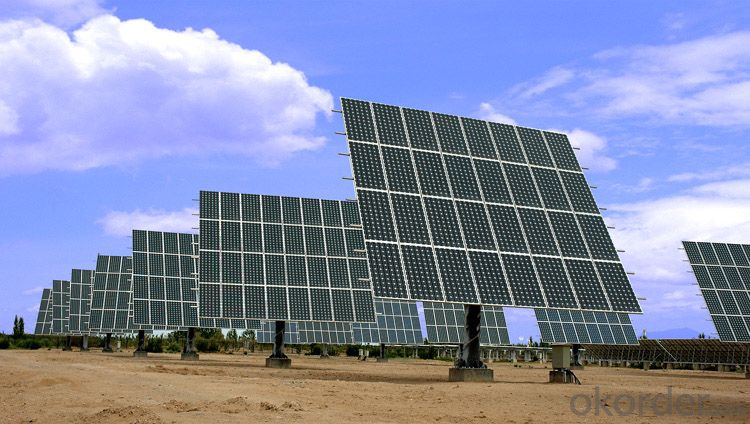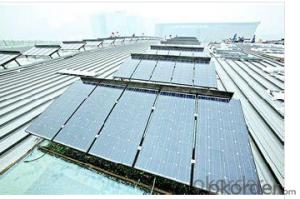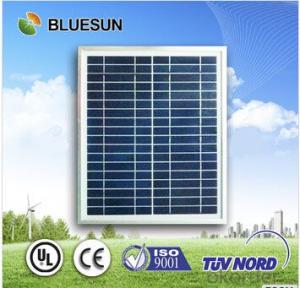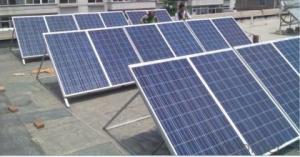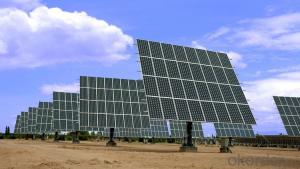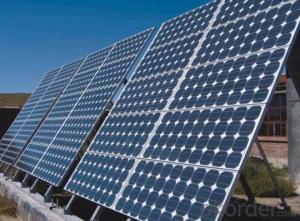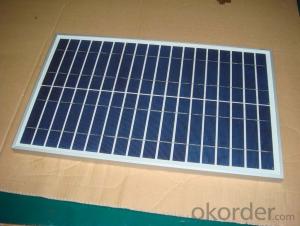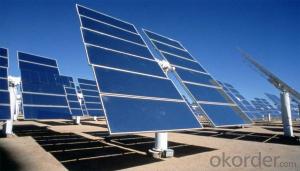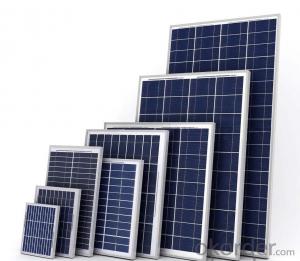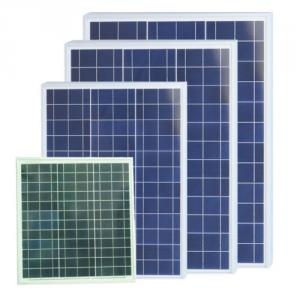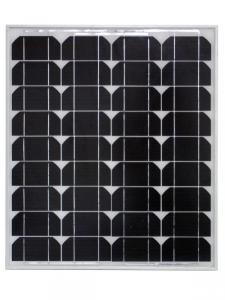Roll Up Favorites Compare 20W Round Monocrystalline Silicon Solar Panel
- Loading Port:
- China Main Port
- Payment Terms:
- TT OR LC
- Min Order Qty:
- -
- Supply Capability:
- 10000000000000 watt/month
OKorder Service Pledge
OKorder Financial Service
You Might Also Like
Quick Details
| Place of Origin: | Guangdong China (Mainland) | Brand Name: | CAP | Model Number: | 50w100w150w200w250w300w |
| Material: | Monocrystalline Silicon | Size: | 1385*1035*75mm | Number of Cells: | 72pcs |
| Max. Power: | 300w | type: | solar panel | color: | blue&black |
| warranty: | 5 years |
Packaging & Delivery
| Packaging Detail: | standard export package for solar panel |
| Delivery Detail: | 7-15 days for solar panel |
Specifications
solar panel
High Efficiency
25 years Warranty
High-transmissivity low-iron tempered glass
Solar Panel
50w100w150w200w250w300w
Characteristics
1,High and stable conversion efficienly based on over 4 years professional experience
2 ,High reliability with guaranteed +/-10% output power tolerance
3,Proven materials,tempered front glass,and a sturdy anodized aluminum frame allow modules to operate reliably in multiple mountily configurations
4,Combination of high efficicncy and attractive appearance
Quality and Safety
1,25 year 80%,10 year 90% power warranty 3 year power warranty
2,ISO9001:2000 (Quality Management system) certified factory
3,Product Quality warranty & products Liability Insurance to guarantee and user' benefits
4,Certifications TUV Intercert, CE Temperature Coefficients
| Module Type | 100w | 150w | 200w | 250w | 300w |
| Maximum Power at ST(Pmax)W | 100wp | 150wp | 200wp | 250wp | 300wp |
| Maximum Power Voltage(Vmp)V | 36/18 | 36/18 | 36/18 | 30.8v | 36/18 |
| Maximum Power Current(Imp)A | 2.77/5.55 | 4.16/8.33 | 5.55/11.1 | 8.11A | 8.33/16.66 |
| Open Circuit Voltage(Voc)V | 39.5/19.05 | 39.3/19.4 | 39.6/19.5 | 36.2V | 39.6/19.8 |
| Short Circuit Current(Isc)A | 3.04/6.09 | 4.58/9.16 | 6.1/12.2 | 8.7A | 9.16/18.33 |
| Cell Efficiency(%) | 18.60% | 18.10% | 18.60% | 17.80% | 18.10% |
| Module Efficiency(%) | 17.70% | 17.20% | 17.70% | 17.10% | 17.20% |
| Operating Temperature°C | -40°C to +85°C | -40°C to +85°C | -40°C to +85°C | -40°C to +85°C | -40°C to +85°C |
| Maximum system voltage | 1000V(IEC)DC | 1000V(IEC)DC | 1000V(IEC)DC | 1000V(IEC)DC | 1000V(IEC)DC |
| Power tolerance | -0.03 | -0.03 | -0.03 | -0.03 | -0.03 |
| Temperature coefficients of Pmax | -0.45%/°C | -0.45%/°C | -0.45%/°C | -0.45%/°C | -0.45%/°C |
| Temperature coefficients of Voc | -0.27%/°C | -0.27%/°C | -0.27%/°C | -0.27%/°C | -0.27%/°C |
| Temperature coefficients of Isc | 0.05%/°C | 0.05%/°C | 0.05%/°C | 0.05%/°C | 0.05%/°C |
| Weight(kg) | 8 | 11 | 14 | 20 | 25.5 |
| Number of cell(pcs) | 4*9 | 4*9 | 6*10 | 6*12 | 6*12 |
| Dimensions(mm) | 1194*534*35/30 | 1580*808*50/35 | 1471*670*40/35 | 1640*992*50 | 2000*1050*50 |
- Q: what do I need to do to disconnect a solar panel from a battery to protect the panel?
- Know that solar panels almost always incorporate a blocking diode to prevent a battery from back-feeding through an un-illuminated panel. Know that solar panels are usually connected to a battery via an electronic switching charge controller, not directly connected. Know that when a solar panel is open-circuited (disconnected from everything) it's terminal voltage will rise to almost twice it's nominal voltage. (22V is common for a 2V panel), unless it is stored in total darkness.
- Q: Are there any limitations to the lifespan of solar panels?
- Yes, there are limitations to the lifespan of solar panels. While solar panels are designed to be durable and long-lasting, they do have a finite lifespan. The average lifespan of solar panels is typically around 25-30 years. However, environmental factors, such as extreme weather conditions, can affect their performance and longevity. Over time, solar panels may experience degradation, reducing their efficiency and power output. Additionally, technological advancements may render older solar panel models outdated or less efficient. Despite these limitations, proper maintenance and regular cleaning can help extend the lifespan of solar panels.
- Q: Can solar panels be used for powering outdoor signage?
- Yes, solar panels can be used for powering outdoor signage. Solar panels convert sunlight into electricity, making them an eco-friendly and cost-effective solution for outdoor signage that is not connected to the grid.
- Q: I've recently started a project to help my store become more green and I need to get some estimates from businesses and if all goes according to plan we will have some panels on our roof and some other measures that I've written into my proposal. Any help is welcome. Just so you know it's a large grocery store in a corporate chain and I've been approved to do all the research, just no promises of payment.
- Google the following: solar panels oregon. Here are a few from the first site listed below. Sorry for the capitalization; that was the site's formatting choice, not mine. SOLAR INC. 3698 Franklin Blvd Eugene, OR 97403 (54) 284-2426 ADVANCED ENERGY SYSTEMS 2990 FOREST BOULEVARD, EUGENE, OR 97405 Phone: (54) 683-2345 ALTERNATIVE POWER MACHINE 4040 HIGHLAND AVENUE, GRANTS PASS, OR 97526 Phone: (54) 476-896 CASCADE SUN WORKS INCORPORATED 2444 SE FIRST STREET, REDMOND, OR 97756 Phone: (54) 548-7887 ENERGY OUTFITTERS LTD. 543 NE E St Grants Pass, OR 97526 (54) 476-4200 ENVIRONMENTAL BUILDING SUPPLIES 89 SE TAYLOR STREET, PORTLAND, OR 9724 Phone: (503) 222-388 KING SOLAR SERVICES 4435 MAPLETON DRIVE, WEST LINN, OR 97068 Phone: (503) 635-5560 MR SUN SOLAR 3838 SW MACADAM AVENUE, PORTLAND, OR 97239 Phone: (503) 222-2468 OERGON SOLAR WATER TALENT, OR 97540 Phone: (54) 535-7332 PROTECH SOLAR 409 PINE STREET, ORETECH, OR 9760 Phone: (54) 882-4545 SOLAR ASSIST 395 CROSS STREET SUITE 2, EUGENE, OR 97402 Phone: (54) 338-4957 SOLAR COLLECTION INCORPORATED 934 PIONEER ROAD, TALENT, OR 97540 Phone: (54) 535-5364 SOLAR DESIGN CONSTRUCTION 825 SE PARK AVENUE, CORVALLIS, OR 97333 Phone: (54) 753-8725 SOLAR ENERGY SOLUTIONS 3730 SE LAFAYETTE COURT, PORTLAND, OR 97202 Phone: (503) 238-4502 SOLAR WIND POWER OF PORTLAND 0006 SW CANYON ROAD, WEST HAVEN SYLVAN, OR 97225 Phone: (503) 297-578 SUMMERS SOLAR SYSTEMS EUGENE, OR 9740 Phone: (54) 683-404 SUMMERS SOLAR SYSTEMS 7342 RAINBOW DRIVE SE, SALEM, OR 97306 Phone: (503) 363-408 SUNBOW SOLAR 074 NW RACHEL STREET, HILLSBORO, OR 9724 Phone: (503) 640-665 SUNLIGHT SOLAR ENERGY 4 NW FRANKLIN AVENUE, BEND, OR 9770 Phone: (54) 322-90 UNITED SOLAR COMPANY 905 SW BUTLER ROAD, GRESHAM, OR 97080 Phone: (503) 666-3065
- Q: I was thinking of having some installed on our rooftop and was wondering if it would be worth the cost? The house is located in Sac, Cali. The panels would face the sun 2 months out of the year and in the summer roughly 4 hours of straight sun.
- You can log in alibaba,i purchased about 20000watts 2 years ago and solar panels work efficiency is fairly high. I hope my answer help you !
- Q: Any opinion on harbor freight solar panels ?
- Put my panel on roof of my motor home, regulator in belly rack with house batterys. Have had no problems in a year or so and they keep the house batterys charged
- Q: Can solar panels be installed on agricultural or farming operations?
- Yes, solar panels can be installed on agricultural or farming operations. In fact, they are increasingly being adopted in these settings to generate clean and renewable energy. Solar panels can be installed on rooftops of barns, sheds, or other structures, as well as on open fields or unused land. By harnessing solar energy, farmers can reduce their electricity costs, lower their carbon footprint, and contribute to a more sustainable farming practice. Additionally, solar panels can provide shading for livestock or crops, minimizing heat stress and improving overall farm productivity.
- Q: I am in need of solar panels and the batteries that I can store the energy in. I need to be able to run a laptop, cell phone, and LED lights from it. When I research I see all sorts of options with regards to watts, VMPs, and AMPs. I also see that I may need a controller, an inverter, and various other components. Can anyone help me through these terms and what i need to know in order to efficiently generate and store the electricity. Thanks
- I think the point you're trying to make is that solar electricity is more expensive than other means of mass produced electricity today, and I would agree. However, that doesn't mean that solar panels are not worthwhile, especially to a consumer in the right location. After the electric company adds in its distribution fees and profit, residential solar electric can actually be cheaper. And in fact, we have had panels on our roof for the past 5 years. Somewhere in the world, there's a factory producing AA batteries to use in flashlights, cameras, and so forth. I'm certain the factory does not run off AA batteries, yet I find AA batteries invaluable for certain things around the house.
- Q: I want to build a standalone wifi repeater -- powered by the sun. The problem is how much solar power and how big of a battery?net draw 4.5v @ 0.66A with loadnet draw 4.5v @ 0.60A no loadI'm assuming the best choice would be a 6v battery with a a couple diodes in series to induce ~.5v drop. Then, I need something to charge it -- I found 2v 6w solar chargers in the automotive section of Sears and 6v 2w solar chargers in the marine section of Dick's Sporting Goods.How many solar panels and what capacity batteries should I use? Is this the best method or should I use a voltage regulator and go with 2v batteries?I need this to be as cheap and simple as possible...
- I do not know, but there is a house in Lafayette which was built with solar power. It was to have a solar system, so the contractor's first act was to put up a solar array on the property. It had battery backup, and was used to provide the electrical power during construction. during completion of the house the solar system was installed on the roof of the house.
- Q: I have an off-grid 24volt existing system using 8 x 80 watt 2volt, wired at 24volts, mono solar panels with deep cycle batteries,operating now. I have been given a 240 2volt polly cryst. panel. Can I add this panel to existing panels as above. Thank you, dumb solar man
- Assuming that you have / will upgrade wiring sizes to carry the extra wattage, that the new total wattage resulting from the addition doesn't overload any existing charge controller, diodes and / or inverter you have installed, then paralleling it straight into one of the other 2 volt groups should do nothing but add current to the system. True, it will be somewhat imbalanced, but it will work. Your other options would be to reconfigure everything down to it's native 2 V configuration which will raise current and lower voltage, with the additional panel creating the additional current to raise the wattage or to put it in series with the other 4 panel clusters so that you would get 36 V and additional current to account for the raised wattage. One last approach might be to set it up on another battery bank of it's own (small and at 2 V) to then connect to the same inverter. You'd be getting more power and storage capability that way, sort of a partial backup system, really, that will take some of the load off the other components to help extend their useful lives and get a bit more flexibility into it as well. The choice is yours here. That is all the ways that the system can be connected in, assuming everything in the first sentence checks out;-) It's difficult to make a recommendation without knowing what other components are in use and what the maximum ratings they carry are. Just remember that parallel connections add current and voltage stays the same, series connections add voltage and the current remains the same and you can figure out what to do with this thing to help you if you stay within maximum ratings for the charge controller, diodes and / or inverter involved. Good luck and stay safe!
Send your message to us
Roll Up Favorites Compare 20W Round Monocrystalline Silicon Solar Panel
- Loading Port:
- China Main Port
- Payment Terms:
- TT OR LC
- Min Order Qty:
- -
- Supply Capability:
- 10000000000000 watt/month
OKorder Service Pledge
OKorder Financial Service
Similar products
Hot products
Hot Searches
Related keywords
